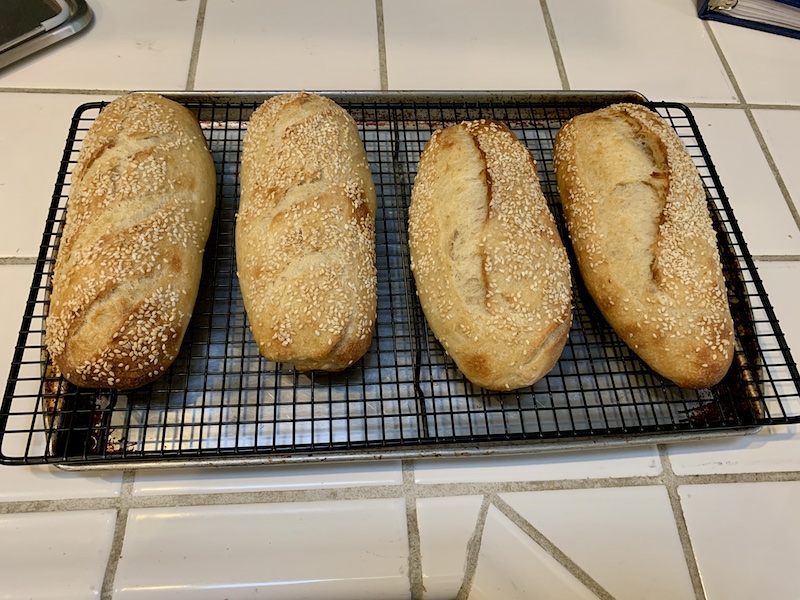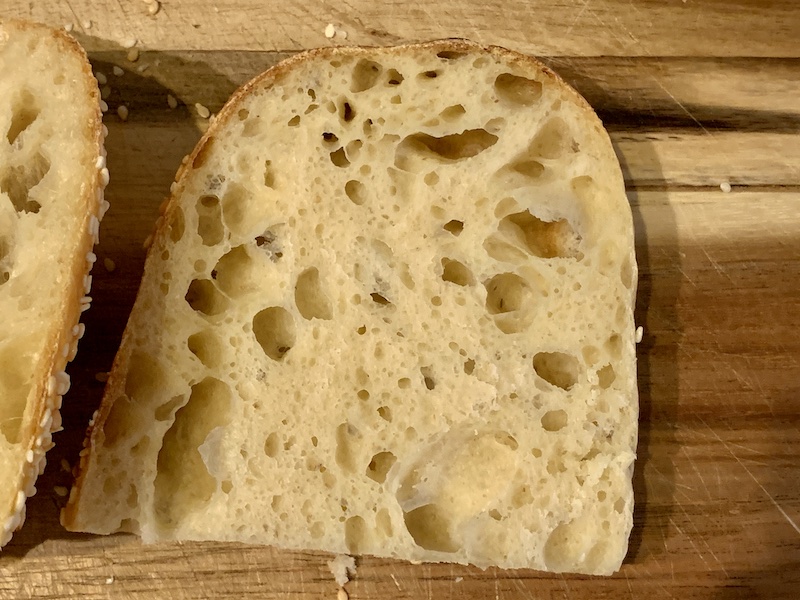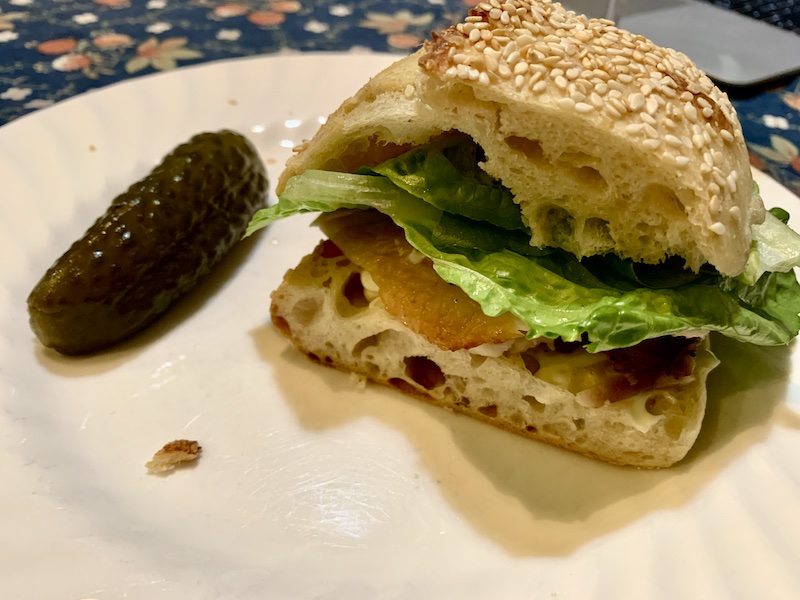
"Italian" San Joaquin Sourdough, a modified method

About a dozen years ago, I developed a version of my San Joaquin Sourdough (SJSD) that was inspired by a type of Italian bread. While SJSD is a lean bread with mixed flours that is cold retarded before dividing, the Italian version was made with AP and Durum flour and was enriched with both sugar and olive oil. It was still cold retarded in bulk.
Recently, there has been a discussion in a BBGA (Bread Bakers Guild of America) group about the pros and cons of retarding bread doughs. That got me wondering about how some of my breads that I always cold retard would be baked the same day as they were mixed. And, since I had wanted to make some rolls for sandwiches, I decided to do my experiment with the Italian version of my SJSD.
In brief, it was a raging success - to my taste, even better than previous bakes which had been retarded in bulk overnight. It was moderately sour, somewhat sweet and had more of the nutty durum flavor. Now, I want to try other breads I have always retarded without retardation.
Here is my formula and procedure:
Sourdough Italian Bread: A SJSD Variant - One Day Version
David M. Snyder
February, 2024
Total Dough |
|
|
Ingredient | Amount (gms) | Bakers' % |
AP flour | 334 | 60.7 |
Fine Durum flour | 200 | 36.4 |
WW flour | 11 | 2 |
Whole Rye flour | 5 | 1 |
Water | 415 | 75 |
Salt | 10 | 1.8 |
Sugar | 14 | 2.5 |
EVOO | 14 | 2.5 |
Total | 1003 | 181.9 |
Liquid Levain |
|
|
Ingredient | Amount (gms) | Bakers' % |
Liquid starter | 40 | 40 |
Water | 100 | 100 |
AP flour | 70 | 70 |
WW flour | 20 | 20 |
Whole Rye flour | 10 | 10 |
Total | 240 | 240 |
- Disperse the liquid starter in the water.
- Add the flours and mix thoroughly.
- Ferment at room temperature until expanded and bubbly (8-12 hours). If necessary, refrigerate overnight and let warm up for an hour before using.
Final Dough |
|
Ingredient | Amount (gms) |
AP flour | 300 |
Fine Durum flour | 200 |
Water | 365 |
Salt | 10 |
Sugar | 14 |
Active liquid levain | 100 |
EVOO | 14 |
Total | 1003 |
Procedures
- In a large bowl, disperse the levain in the water.
- Add the flours and sugar to the liquid and mix to a shaggy mass.
- Cover the bowl and let it rest for 20-60 minutes.
- Add the salt and olive oil and mix thoroughly. (Note: I squish the dough with my hands until it comes back together, then do stretch and folds in the bowl until it forms a smooth ball and the oil appears completely incorporated.)
- Transfer the dough to a 2 quart lightly oiled bowl, and cover the bowl tightly.
- After 30 minutes, do stretch and folds in the bowl.
- After another 50 minutes, do a stretch and fold on a lightly floured board.
- Continue bulk fermentation for another 1-2 hours, until the dough is puffy. If fermented in a glass bowl, you should see lots of little bubbles throughout 3the dough. Volume of the dough may have increased by 50% or so.
- Divide the dough into 2 to 4 equal pieces and pre-shape as rounds or logs. Cover with a clean towel, baker's linen or plasti-crap and let rest for 10-20 minutes.
- Shape as Bâtards, Demi-Baguettes or Ficelles.
- Roll the loaves on damp paper towels, then in a tray of sesame seeds. Alternatively, you can brush the loaves with water and sprinkle with sesame seeds.
- Proof for about 45 minutes seam-side up on parchment paper or seam-side down on linen, pleated to separate the loaves and supported at both long sides by rolled-up dish towels. Cover with a damp towel, baker's linen or plasti-crap.
- One hour before baking, pre-heat the oven to 480ºF with a baking stone and steaming apparatus in place.
- When ready to bake, uncover the loaves and transfer the loaves to a peel, seam side down.
- Score them as baguettes or bâtards, according to their shape. Steam the oven and transfer the loaves to the baking stone.
- After 12 minutes, remove the steaming apparatus. Continue baking for another 8-15 minutes until the loaves are nicely browned and the internal temperature is at least 205ºF.
- Transfer the loaves to a cooling rack. Cool completely before eating.



Roast chicken sandwich.
Happy baking!
David


Comments
So why do you think the bread was more flavorful without the overnight bulk retardation ? I’ve been doing an overnight bulk forever as it fits in my schedule much better and was always under the impression that a slow and cool bulk develops more flavor.
Best regards,
Ian
it's hard to say, based on a single bake. For example, I fermented the levain overnight - around 9 hours. It was very ripe, but not collapsed. I suspect that was a significant part of the flavor.
I have had the same impression as you about retardation yielding increased flavor complexity. But, you know, a lot of the "science" of sourdough baking is folklore. And laboratory results don't always carry through in the bakery.
David
Always a pleasure to read your write-up and to see the photos of your breads. This looks like another stellar result.
Do you find that the rye and whole wheat actually add distinct flavors with so small amounts being used?
Ted
I'm happy you enjoy my postings.
The rye and whole wheat in this bread are entirely in the levain. I think they contribute to the levain's vigor more than the final bread's flavor. Now, in my "normal" SJSD, the rye and whole wheat definitely contribute to the flavor complexity. The SJSD final dough flour mix is 90% AP and 5% each whole rye and whole wheat. I discovered years ago that even a relatively tiny amount of whole rye in a mostly white bread improved the bread's flavor significantly.
David
You’ve achieved quite an open crumb for a 40% durum semolina bread. I like that you’ve used AP flour instead of bread flour, perhaps that helped with this open crumb.
Your observations about the flavor without cold retarding the dough are interesting. I seldom do overnight cold retards of my doughs. For most I make an overnight levain, then bulk in the morning and bake later in the day. At most I might add a period of cold (either freezer or fridge or combination of both) to firm up the dough prior to scoring. When I have done a long overnight cold retard the only difference I have found it that I might get more blisters on the crust. I have never really felt my breads were more complex in flavour. But it is quite possible that my palate isn’t that sensitive so I might not be able to taste these differences unless they were profound.
Benny
Overnight cold retardation is often convenient. I think I started using it as much as I do because so many bread baking authorities advocated it to increase flavor. I never did anything like a controlled experiment, but, since my breads were so tasty, I never felt the need to do so. At this point, there are at least two other breads I have always retarded I want to try baking without this. Stay tuned!
One other thing: The durum flour I used is the finely milled type, not the coarser semolina.
David
I have been baking a mild variant of SJSD for years now and always do an overnight retardation as it's just convenient in terms of freeing up the day after doing the initial rise. Where did you source the durum flour from? I know that King Arthur has a semolina specialty flour which is 100% durum but I don't know how finally milled it is. Our local grocer had some of KA's pizza flour on the shelf (00 milled) and I've used it several times to make a Neapolitan style pizza which was very tasty with a nice thin and crisp crust. I'm not sure that this would be a direct replacement in your recipe.
alan
Hi, Alan.
I have two sources for Fine Durum Flour. Here are links:
https://shop.kingarthurbaking.com/items/durum-flour
https://centralmilling.com/product/organic-whole-durum-flour/
Central Milling also sells what I would call a "White Durum" flour for pasta making. I use the whole grain durum.
https://centralmilling.com/product/organic-extra-fancy-durum-pasta-flour/
David
Many of my favorite recipes have come from your posts and this one has been added to my list. I originally followed your recipe and baked sandwich rolls, and yesterday doubled the recipe and made two large bâtards. The flavor and the texture are outstanding and I'm looking forward to my sandwiches in the next couple of weeks.
Richard
Do you recall what temperature you did your bulk and final proof at? I just did a same day bake for the first time in years and ended up slightly over proofing.
Thanks
Ian